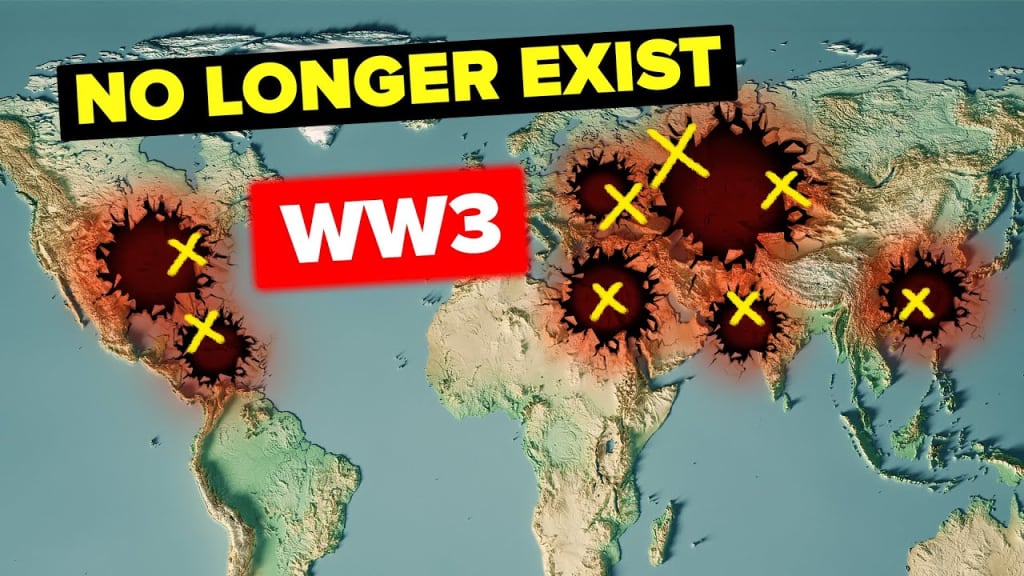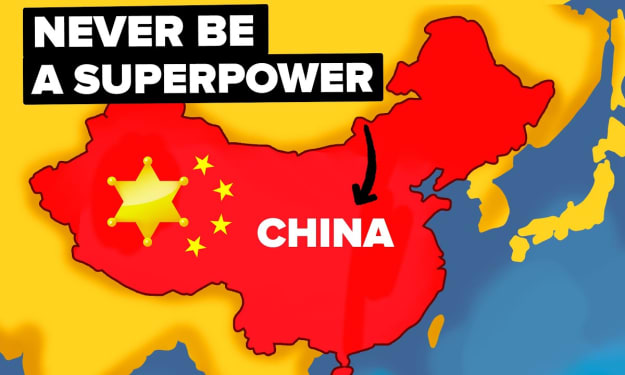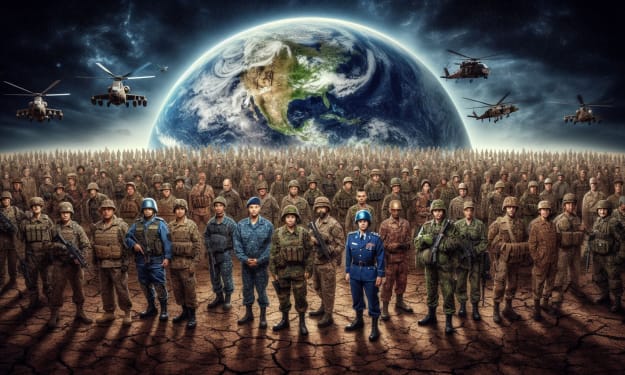Which countries in the globe will be annihilated by World War 3?
The treaties are done, the weaponry are on full alert, and World War 3 is on the horizon. Where is the ideal location to be... And which nations are doomed to be annihilated in the largest global battle in 80 years? Get on this eye-catching revelation to find out which nations will be entirely wiped out!

They No Longer Exist (WW3) 💣❌🤯
The treaties are done, the weaponry are on full alert, and World War 3 is on the horizon. Where is the ideal location to be... And which nations are doomed to be annihilated in the largest global battle in 80 years? Get on this eye-catching revelation to find out which nations will be entirely wiped out! 💣❌🤯
- Negotiations are over, the weapons are on high alert, and World War 3 is imminent. Where is the best place to be, and which countries are destined to be destroyed in the biggest global conflict in 80 years? The answer is a little more complicated than it appears. To start, we need to figure out what World War 3 is likely to mean. The world has had plenty of conflicts in the last few decades, but they're usually either caused by a powerful country imposing its will on a smaller one or invading it for a specific purpose, like we're seeing in Ukraine right now and Iraq in the early 2000s. There have also been thorny regional conflicts, like the constant border skirmishes between India and Pakistan, but none have exploded into World War 3.
- And when it does happen, well, you probably know it. World War III is likely to involve two major blocs of nations around the world. On one side, we see the United States and its NATO allies: most of Western Europe, along with Canada, Australia, New Zealand, Japan, and South Korea. India and Israel, both of which have strong ties to this bloc, are likely to work with them as well. Then, in the other corner, we have the United States' two closest rivals for the superpower crown: Russia and China. While the two countries aren't in perfect harmony over Russia's invasion of Ukraine, they both view the US as their chief rival and are likely to work in sync if a war breaks out.
- China would likely pull its two nuclear-armed allies, Pakistan and North Korea, along with the ambitious Iranians, who are looking to join the nuclear club. A smaller group only joined by a select few other nations, but certainly a powerful bloc in terms of military strength. And this conflict will start in a familiar place. World War 3 isn't likely to break out of nowhere; it'll be the continuation of ongoing conflicts, and the most likely flashpoint is in Eastern Europe. If Russia takes the continued supply of NATO weapons to Ukraine as a declaration of war or attacks a NATO nation directly, it would trigger Article 5 and bring all NATO members into the war.
- Likewise, if Russia wins the war in Ukraine and declares it Russian territory, it then might view NATO's presence on its border as a provocation, and just like in 1939, the battle for Europe would begin. And when one conflict breaks out, others are sure to follow. Ukraine is to Russia what Taiwan is to China—the larger power has never given up hope of reclaiming it, even after decades. And in China's case, they've never even acknowledged Taiwan as an independent nation. The chaos in Europe has created the perfect chance for China to move on Taiwan and try to conquer it without getting into a larger war, hoping that the United States, which has pledged to defend Taiwan, would be too busy to jump into the fray.
- Of course, if that gambit fails, we are likely to have a shooting war between the US and China across the Pacific Ocean. And this explosion of conflict could lead to more flare-ups. Would North Korea take advantage of China's move on Taiwan to launch its own assault on South Korea? Would the ongoing India-Pakistan border conflicts break out into something larger? Would the Iranian Mullahs finally try to destroy Israel, potentially triggering retaliation from the secret nuclear power? Who else will get involved—and who will be left standing when the smoke clears? First, let's look a little at who's likely to come away scot-free. The safest continent to be on during the outbreak of World War 3 might just be South America.
- The continent is heavily dominated by mainstream left-wing parties that have friendly relations with both the United States and Russia, so the odds are they'll stay neutral in any conflict. All these countries are democracies, with the exception of chaotic Venezuela. Also working in their favor is the fact that no South American country has nuclear weapons, and most have militaries only designed for domestic use. Not only are they unlikely to get involved directly in any conflict, but there isn't likely to be any motivation for a country to invade them. While it's possible they could be used as a staging ground for attacks on the north, there are much easier ways to attack the United States.
- Thus, the only thing South America likely has to worry about in World War 3 is nuclear fallout drifting their way if everything gets completely out of control. They're not the only countries that can breathe easy. Probably the most remote country in the world, New Zealand is in a lucky position. While it is firmly aligned with the Western Bloc and its fate is closely tied to that of its much larger neighbor Australia, it is more likely to avoid trouble for one simple reason: Australia is a pretty good shield. Australia is a massive nation that is closely tied to NATO and hosts US and British military facilities. While it is unlikely that Australia will be totally destroyed, as it is a large country with a small military force, it could definitely find itself occupied by a foreign army.
- But would these invaders proceed to New Zealand? The answer is probably not. New Zealand doesn't pose much of a threat militarily and is one of the most remote countries in the world. If they didn't get directly involved, new Zealand might be able to ride out the war. And as Australia is unlikely to be targeted by nuclear weapons, fallout will likely not be a threat. And the same goes for a continent that's breathing a sigh of relief. For hundreds of years, Africa has been treated as an all-you-can-eat buffet by colonial powers, with almost all the countries on the continent being invaded, colonized, and looted of their resources and even their people. Today they have a complex relationship with the world's great powers, but many countries are seeing their economies grow at an astonishing rate, and other countries invest in factories and talent there.
- China in particular has seen its investment on the continent grow, with many key factories producing high-tech components used in military warfare being hosted in these nations. Africa has no nuclear powers, and its militaries are unlikely to get directly involved in any conflict, so the most likely problem Africa is going to face is dealing with rival powers interfering in each other's investments. But for other countries, prospects are thornier. Could the United States survive World War 3? They have a few advantages. For one thing, they were still relatively isolated from main flashpoints, which also allowed them to experience minimal conflict on the home front during the first two world wars.
- But this time there's an additional threat: nuclear weapons, which mean that the enemies can hit any country, anywhere in the world. It's believed only Russia and China have the ability to hit the US homeland right now, with North Korea trying to join the party. The US is also very spread out, with dozens of cities dotted around the world's third-largest country. While it could sustain some massive hits if the war goes nuclear, it is well-equipped to survive, and if its survival is truly in danger, so is the rest of the world. Its most vulnerable areas may be its Pacific holdings, including the state of Hawaii and the territory of Guam. And its neighbors are largely in the same boat.
- There is a reason there isn't likely to be any major conflict on North American soil: all of the countries there are relatively friendly with each other. Canada is a member of NATO and a close ally of the United States, and the two are likely to be on the same side. Relations with Mexico can be tense, and the country was famously approached to join Germany in World War One with the promise of reclaiming lost territory, but it is unlikely to actively oppose the US. These two countries aren't likely to be targeted directly during the war except in a full-scale nuclear barrage, although Canada is uniquely vulnerable in some ways. That's because, despite being the world's second-largest country, the vast majority of its population is located in less than ten cities, less than an hour from the US border.
- And in the same boat is one of the ringleaders of the other side. China is likely to be a key player in World War III, along with Russia, as the leaders of the forces opposing the US and its allies. But it is in a better position strategically. For one thing, the belligerent Vladimir Putin is more likely to provoke retaliation from his enemies with big, flashy war crimes, while the ruthless Xi Jinping will be able to stay further under the radar. China is also roughly the size of the United States and is the most populous country in the world. If things escalate to nuclear weapons, the country will almost certainly take massive blows – most likely from the US, but also possibly from India – but it will be extremely difficult for its enemies to destroy the country without endangering the future of all life on Earth.
- The same can't be said for these countries. These are the ones that are in the biggest danger of being wiped off the map. We have to start with the most vulnerable countries in the case of World War III breaking out: Ukraine and Taiwan. If this global war starts, it'll likely start right here, and some might say it already has. Right now, Ukraine is turning the tide on Russia. They're supplied with heavy-duty NATO artillery and are shooting down Russian planes and blowing up their ships, while Russia is limited to committing indiscriminate war crimes with an army increasingly staffed with draftees. But if Putin gets backed into a corner and starts using nuclear weapons, the tide could turn very quickly, and Ukraine could see its largest cities destroyed in a flash.
- From there, it would be overrun, and the devastated country would become little more than a staging ground for Putin's next conquest. And the same could happen half a world away. China is less likely than Russia to use nuclear weapons against Taiwan, mostly due to Taiwan's small size. Such an attack could destroy the small island, but because of China's ambition to reincorporate the nation, this is unlikely. In order to do that, it would likely start with a shock-and-awe attack, hitting Taiwan with a naval assault, blasting through its defenses, and likely causing mass destruction as well as loss of power and access to resources in its largest city, Taipei. This would all happen very quickly, and while Taiwan could likely hold out for a while, China has more resources and deadlier weapons.
- Unless the United States got directly involved and started firing back, Taiwan would likely still exist as a plot of land, but the nation, its government, and its people would become nothing more than a pawn and hostage for China. Back in Europe, Ukraine isn't the only country in danger. Putin has had his sights on access to the Baltic Sea for a long time, as its only water access is limited. The odds are that these small nations would be first on the chopping block once Putin triumphs over Ukraine and World War 3 is on. All these countries—Estonia, Lithuania, and Latvia—are in NATO, but any pretenses of respecting that larger alliance are likely out the window at this point.
- Putin will be looking to reclaim the borders of the old Soviet Union, and these countries all border Russia or its puppet state in Belarus. That makes them easy pickings. And the countries to Russia's south aren't any safer. Russia has long held that it wants NATO off its border, and NATO members close by would likely be its first targets. That includes Moldova and Romania, and in those cases, there's an especially thorny issue to discuss. A semi-autonomous region called Transnistria is claimed by both Russia and Moldova, but Russia has long held that the region's residents would like to join Russia. Is this true? No one knows, and any referendum they hold would likely be conducted at gunpoint, just like the ones in the Donbas.
- However, if a larger conflict breaks out, Russia is likely to march in and take Transnistria – and possibly Moldova as well. If things went further, much like in the Baltic States, this would lead to war with NATO, as the next country in the region on Russia's chopping block is Romania, which is a member of NATO, but Putin is largely past the point of caring. In fact, just about all areas of Europe could be facing an existential threat. While Russia is gigantic, the same can't be said about any of its neighbors. In the event of a full-on nuclear war, most of Putin's enemies could find themselves suffering massive destruction and loss of life.
women in politicswhite housevotingvintagetv reviewtrumptraveltransportationtradetechnologysupreme courtsocial mediasatirereviewquotespresidentpop culturepoliticspoliticiansphotographyopinionnew world ordermovie reviewliteraturelistlegislationinterviewhumanityhow tohistoryfinancefeaturefact or fictionenergyeducationdefensecybersecuritycorruptioncontroversiescongresscelebritiesbook reviewsartagricultureactivism
Like
Share






Comments
There are no comments for this story
Be the first to respond and start the conversation.